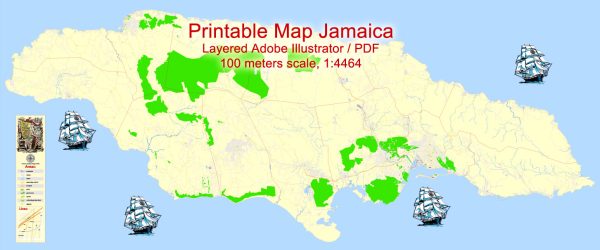Jamaica is an island nation located in the Caribbean Sea. It is the third-largest island in the Caribbean and is situated to the south of Cuba and to the west of the island of Hispaniola (shared by the Dominican Republic and Haiti). Here are some key geographical features and descriptions of Jamaica:
- Island Geography: Jamaica is an island country, and it is the main island of the nation. It has a total land area of approximately 4,240 square miles (10,991 square kilometers).
- Coastline: Jamaica is known for its beautiful coastline, which stretches for about 1,022 kilometers (635 miles). The island is surrounded by the Caribbean Sea to the south and the warm waters of the Atlantic Ocean to the north.
- Mountains: The central part of Jamaica is dominated by the rugged terrain of the Blue Mountains, which run along the eastern side of the island. The Blue Mountain Peak, the highest point in Jamaica, reaches an elevation of 2,256 meters (7,402 feet) above sea level.
- Valleys and Plateaus: Between the mountain ranges are fertile valleys and plateaus, such as the Cockpit Country and the Queen of Spain Valley. These areas are known for their lush vegetation and agricultural significance.
- Rivers and Waterfalls: Jamaica has numerous rivers, with the Black River being one of the most prominent. Dunn’s River Falls, near Ocho Rios, is one of the most famous waterfalls and a popular tourist attraction.
- Beaches: Jamaica is renowned for its stunning beaches, particularly along the northern and western coastlines. Negril, Montego Bay, and Ocho Rios are popular beach destinations.
- Coral Reefs: The waters surrounding Jamaica feature vibrant coral reefs, making it a popular destination for snorkeling and scuba diving. The Montego Bay Marine Park and Negril Marine Park are protected areas for marine life.
- Climate: Jamaica has a tropical climate with a wet season from May to October and a dry season from November to mid-December. The average temperatures range from 77°F (25°C) in January to 88°F (31°C) in July.
- Flora and Fauna: The island is rich in biodiversity with a variety of tropical plants and wildlife. You can find a wide range of bird species, reptiles, and marine life.
- Natural Beauty: Jamaica’s natural beauty extends beyond its landscapes to its vibrant culture, reggae music, and friendly people, making it a popular tourist destination.
Jamaica’s diverse geography and natural beauty have made it a popular destination for tourists seeking sun, sea, and adventure. The island’s unique blend of cultures, rich history, and natural wonders make it a distinctive and captivating place to visit or live.


 Author: Kirill Shrayber, Ph.D.
Author: Kirill Shrayber, Ph.D.